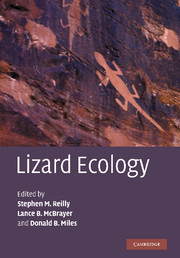Book contents
- Frontmatter
- Contents
- List of contributors
- Preface
- Historical introduction: on widely foraging for Kalahari lizards
- I Organismal patterns of variation with foraging mode
- 1 Movement patterns in lizards: measurement, modality, and behavioral correlates
- 2 Morphology, performance, and foraging mode
- 3 Physiological correlates of lizard foraging mode
- 4 Lizard energetics and the sit-and-wait vs. wide-foraging paradigm
- 5 Feeding ecology in the natural world
- 6 Why is intraspecific niche partitioning more common in snakes than in lizards?
- 7 Herbivory and foraging mode in lizards
- 8 Lizard chemical senses, chemosensory behavior, and foraging mode
- 9 Patterns of head shape variation in lizards: morphological correlates of foraging mode
- 10 Prey capture and prey processing behavior and the evolution of lingual and sensory characteristics: divergences and convergences in lizard feeding biology
- 11 The meaning and consequences of foraging mode in snakes
- II Environmental influences on foraging mode
- Index
- References
2 - Morphology, performance, and foraging mode
Published online by Cambridge University Press: 04 August 2010
- Frontmatter
- Contents
- List of contributors
- Preface
- Historical introduction: on widely foraging for Kalahari lizards
- I Organismal patterns of variation with foraging mode
- 1 Movement patterns in lizards: measurement, modality, and behavioral correlates
- 2 Morphology, performance, and foraging mode
- 3 Physiological correlates of lizard foraging mode
- 4 Lizard energetics and the sit-and-wait vs. wide-foraging paradigm
- 5 Feeding ecology in the natural world
- 6 Why is intraspecific niche partitioning more common in snakes than in lizards?
- 7 Herbivory and foraging mode in lizards
- 8 Lizard chemical senses, chemosensory behavior, and foraging mode
- 9 Patterns of head shape variation in lizards: morphological correlates of foraging mode
- 10 Prey capture and prey processing behavior and the evolution of lingual and sensory characteristics: divergences and convergences in lizard feeding biology
- 11 The meaning and consequences of foraging mode in snakes
- II Environmental influences on foraging mode
- Index
- References
Summary
Introduction
The feeding behavior of an animal is a fundamental attribute that has major fitness implications. Individual variation in the success with which prey is acquired ultimately affects growth rate, survivorship and reproductive success. Foraging success is linked to search behavior, which profoundly influences the variety and number of prey encountered (Pianka, 1966, 1973; Pietruszka, 1986). The ability to find prey therefore affects food intake and ultimately an individual's energy budget. The importance of foraging success is manifest in the myriad of behaviors animals display for the searching, pursuit, and capture of prey. Different modes of search behavior also entail costs. The duration of time spent foraging and the type of habitat an animal searches for food affects the risk of predation and ability to avoid predators (Huey and Pianka, 1981).
Not surprisingly, the analysis of foraging behavior has been an important topic in ecology and evolutionary biology (Schoener, 1971; Gerritsen and Strickler, 1977; Stephens and Krebs, 1986; Perry and Pianka, 1997). Past investigations proposed a dichotomy in foraging patterns based on observations of consistent and prominent differences in behaviors among species in how prey are pursued and captured (see McLaughlin, 1989; Vitt and Pianka, this volume, Chapter 5; Perry, this volume, Chapter 1). Most species have been classified as either “ambush” (“sit-and-wait”) predators or widely (active) foraging predators (Pianka, 1966; Regal, 1978; Huey and Pianka, 1981) based on qualitative examination of activity patterns in the field.
- Type
- Chapter
- Information
- Lizard Ecology , pp. 49 - 93Publisher: Cambridge University PressPrint publication year: 2007
References
- 32
- Cited by



